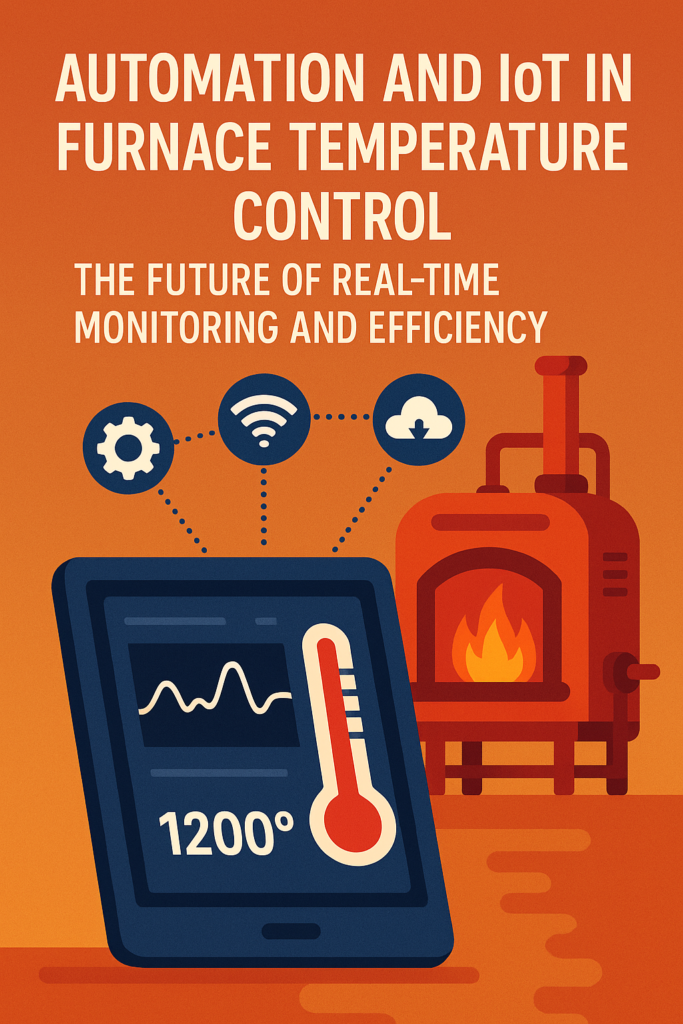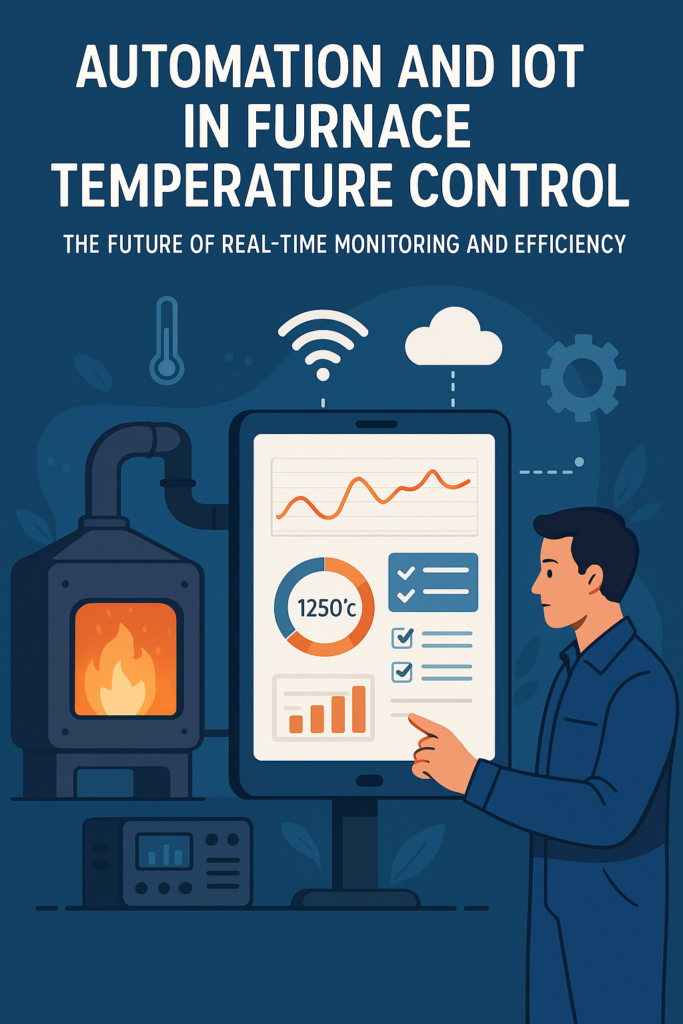
In the world of heat treatment processes, precise temperature control is crucial. Whether it’s for hardening, annealing, or tempering, maintaining an accurate temperature ensures that materials are treated to their exact specifications, yielding optimal results. Traditionally, furnace temperature control has been managed manually or with basic automated systems. However, with the rise of Automation and the Internet of Things (IoT), furnace control systems have evolved to become more intelligent, efficient, and capable of providing real-time insights. This blog explores how IoT and SCADA systems are revolutionizing furnace temperature control, along with the benefits of cloud-based solutions for predictive maintenance.
Integration of IoT for Real-Time Monitoring and Remote Control
In the past, furnace operators relied on basic thermostats or manual controls to adjust the furnace temperature. This often led to inefficiencies, downtime, or errors in achieving the desired temperature. With IoT integration, heat treatment furnaces can now be equipped with smart sensors that continuously monitor temperature, pressure, humidity, and other vital parameters. These sensors are interconnected via the internet or local networks, providing real-time data to a central monitoring system.
Here’s how IoT transforms furnace control:
- Remote Monitoring: Operators can now access temperature data from anywhere in the world via an internet-connected device. This allows for quicker decision-making and reduces the need for constant physical presence in the facility. If a temperature anomaly occurs, operators can be alerted immediately, minimizing the risk of damaged materials or energy waste.
- Automatic Adjustments: With advanced sensors, the system can automatically adjust the furnace’s heating elements or cooling systems based on real-time readings. This enhances the furnace’s ability to maintain a consistent temperature, ensuring more uniform treatment of materials.
- Data Logging and Analytics: IoT devices continuously collect data, which is stored and processed for trend analysis. This data can help identify patterns in furnace performance, allowing for adjustments that optimize energy consumption and improve operational efficiency.
- Predictive Alerts: IoT systems can also send alerts if any sensor readings deviate from the normal range. This can help prevent potential failures by notifying operators before problems become severe, allowing for immediate action to correct or prevent issues.
Use of SCADA Systems for Monitoring Furnace Parameters
While IoT provides the hardware for real-time data collection, SCADA (Supervisory Control and Data Acquisition) systems offer the software backbone for data analysis and management. SCADA systems enable operators to visualize and control furnace parameters from a centralized interface, providing a higher level of control and efficiency.
Here’s how SCADA enhances furnace temperature control:
- Centralized Control: SCADA systems integrate all furnace components (e.g., heating elements, sensors, alarms) into a single interface. Operators can view real-time furnace performance across multiple units simultaneously, streamlining monitoring and decision-making processes.
- Comprehensive Data Visualization: SCADA systems display data through graphical interfaces, which make it easier for operators to identify irregularities, trends, and potential problems. For example, temperature readings can be displayed in graph form, making it easier to spot spikes, drops, or plateaus.
- Event Management and Alarming: SCADA systems offer sophisticated alarming capabilities. If a temperature exceeds or drops below a preset threshold, the system will trigger an alarm. This allows operators to take corrective action promptly, avoiding damage to both the materials and the furnace itself.
- Automation and Control: SCADA systems allow for automated temperature adjustments. If the system detects a temperature deviation or system malfunction, it can trigger an automatic correction. This reduces human error and enhances the furnace’s ability to maintain a stable and precise temperature environment.
- Historical Data Analysis: SCADA not only offers real-time monitoring but also stores historical data for trend analysis. This data can be used to analyze furnace performance over time, offering insights into efficiency, energy use, and potential areas for improvement.
Cloud-Based Solutions for Predictive Maintenance and Performance Analytics
As manufacturing processes become more complex, cloud-based solutions are emerging as a critical tool for improving furnace performance and reliability. These solutions enable the integration of data from various sources, including IoT devices and SCADA systems, to provide powerful analytics and predictive insights.
Here’s how cloud-based solutions help in furnace temperature control:
- Predictive Maintenance: Traditional maintenance strategies often rely on scheduled inspections or reactive repairs, which can lead to costly downtime. Cloud-based solutions enable predictive maintenance by using machine learning algorithms to analyze historical and real-time data. This allows operators to predict when a furnace or component is likely to fail based on usage patterns and sensor data, enabling maintenance to be scheduled only when necessary—before a failure occurs.
- Remote Monitoring and Control: Cloud platforms allow for continuous monitoring of the furnace parameters, even when operators are off-site. With cloud-based dashboards, data can be accessed from anywhere at any time, giving operators the flexibility to manage furnaces remotely. This is particularly useful for multi-location facilities or for operations requiring 24/7 monitoring.
- Data-Driven Insights: Cloud solutions allow manufacturers to harness the power of big data. By aggregating and analyzing large amounts of data from multiple furnaces, manufacturers can gain insights into performance optimization. For example, trends in temperature fluctuations can highlight inefficiencies in the furnace’s heating system, which can then be addressed to improve overall performance.
- Scalability and Flexibility: Cloud-based solutions are scalable, meaning they can grow with your operations. Whether you have a single furnace or a fleet of hundreds, cloud platforms can handle the increased data load. Additionally, as cloud solutions often come with subscription-based pricing, they provide a cost-effective way to implement advanced monitoring and analytics.
- Improved Decision Making: By integrating data across multiple furnaces, cloud-based platforms provide a holistic view of the entire operation. This enables better decision-making regarding energy consumption, operational efficiency, and maintenance planning.

Conclusion: A Smarter, More Efficient Future for Furnace Temperature Control
The integration of IoT, SCADA, and cloud-based solutions is transforming furnace temperature control systems, making them more efficient, reliable, and capable of handling modern manufacturing demands. With real-time monitoring, remote control, and predictive maintenance, these advanced systems help optimize furnace performance, reduce downtime, and improve energy efficiency.
As technology continues to evolve, we can expect even more innovations in automation and IoT that will further enhance furnace temperature control, ensuring better quality products, more consistent results, and greater operational efficiency.
Embracing these smart technologies not only leads to a more efficient furnace system but also positions manufacturers at the forefront of Industry 4.0, ready to take advantage of the future of manufacturing automation.






Leave a Reply